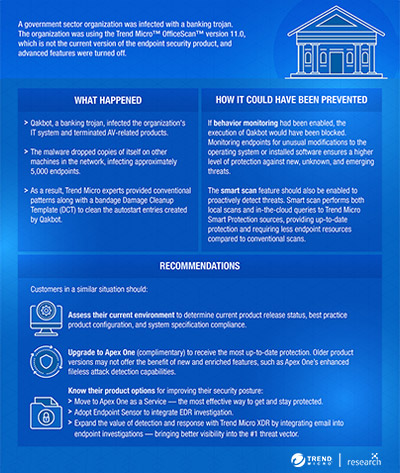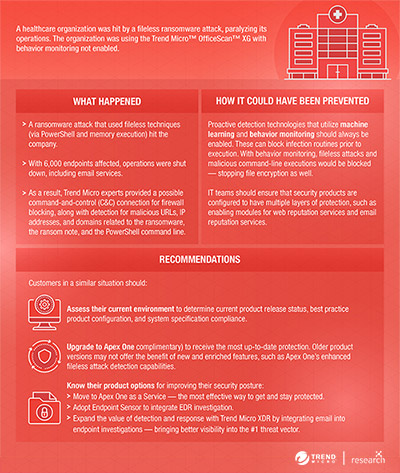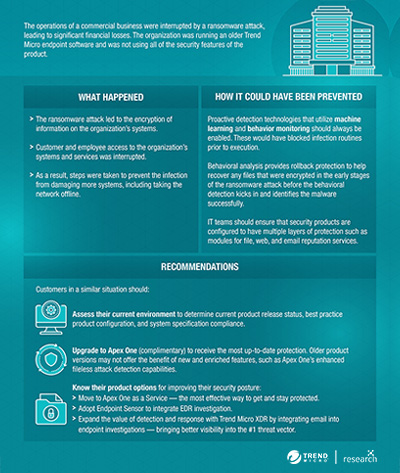Dynamic Challenges to Threat Detection and Endpoint Security — And How to Overcome Them
Technology today is swift, evolutionary, and cutting-edge. Because of this, IT environments — both at home and at work — are continuously adapting to such rapid acceleration. In order to stay ahead of the curve, users and organizations need to arm themselves with technologies that ultimately work to make their day-to-day easier.
However, cybercriminals are also steadily keeping pace. They relentlessly tweak old pieces of malware or create novel ones that abuse software, applications, services, networks, and systems — all in the name of penetrating ever-changing environments for their own profit. These threats are crafted with detection evasion in mind to allow malicious payloads to better circumvent regular threat detection and endpoint security solutions. The impact of these evasive threats are pervasive, affecting businesses and governments as well as users.
Advancements in technology continue to grow — and so do the techniques of cyberthreats. How can organizations keep their evolving environments protected?

Dynamic Cybersecurity Challenges
As a result of great technological advancements, our environments are steadily changing. Now more than ever, individuals and organizations rely on technology to make life more dynamic. And this reliance on technology and the consequent expanding attack surface are what cybercriminals bank on as they create threats that are meant to trick users and organizations.
Take for example how organizations are drawn to making processes more streamlined and convenient. This is why more and more businesses adopt DevOps — to increase efficiency and scalability of their products and services. But threat actors are constantly developing a slew of attacks, such as deploying ransomware and using malicious code injection techniques that bring down production times and financially hurt businesses. On top of these threats, misconfiguration remains to be the undoing of many organizations using cloud-based applications and platforms, allowing cybercriminals to gain illicit access to cyberassets to mine cryptocurrency or download the personally identifiable information (PII) of millions of individuals.
Another development is the increasing ubiquity of IoT devices. These smart devices communicate wirelessly within homes, transforming routines into seamless and automated daily experiences. They also play a role in transforming the world of work, with remote work and bring-your-own-device (BYOD) programs now becoming a norm. However, these devices can be hacked into — compromising users’ safety and privacy and companies’ critical and sensitive assets. Cybercriminals can compromise IoT devices and create a malicious botnet that can then be used to target servers and send vast numbers of spam emails containing malware. When left unprotected, the devices that make tasks simpler can be the very things that put users and data at risk.
Because of the sophistication of today’s threats, organizations have difficulty getting accurate and timely threat detection and investigation, even with endpoint detection and response (EDR) solutions in place — especially if these solutions do not provide speed as well as a broad visibility throughout the enterprise’s connected infrastructure. Aside from this, organizations may have a slew of cybersecurity products that produce a lot of data that would consume considerable amounts of resources, time, and finances to effectively maintain and analyze.
Even with skilled personnel at an organization’s disposal, the sheer volume of tasks involved with investigating issues and sifting through gray alerts take the time they could be spending strengthening and improving their infrastructure. And as organizations take on new applications and software to further drive innovation and operations, in-house cybersecurity professionals are left more and more inundated. Not to mention how cybercriminals continue to evolve their attacks to avoid detection or maintain persistence in systems, from steganography to fileless techniques.
It is evident that dynamism is found not just in the technologies that drive productivity but also in security challenges and threats. This only means cybersecurity should also be dynamic.
Step Up Your Threat Detection and Endpoint Security
As threats continue to evolve and as the attack surface becomes more expansive, enterprise environments need to have stronger, more comprehensive multilayered protection.
Individuals and organizations can take advantage of endpoint security and threat detection solutions that make use of proactive machine learning techniques, such as behavior monitoring. Behavior monitoring will be able to detect any unusual modifications to the operating system or on installed software or applications. Malicious behavior will be automatically blocked, keeping environments secure. Aside from behavior monitoring, another advanced tool is Trend Micro’s smart scan feature, which can deliver real-time threat scanning by comparing possible malicious files with cloud-stored threat signatures.
Below are some real-world examples of situations where a multilayered protection with behavior monitoring and smart scan would have been able to prevent compromise.
Go Further With Trend Micro XDR and Managed XDR
Organizations and governments can benefit from advanced Trend Micro solutions that can proactively keep IT environments protected from a wide range of cybersecurity threats. The Trend MicroTM XDR solution effectively protects connected emails, endpoints, servers, cloud workloads, and networks. Trend Micro XDR uses powerful AI and expert security analytics to correlate data, as well as deliver fewer yet higher-fidelity alerts for early threat detection. In a single console, it provides a broader perspective of enterprise systems while at the same time giving a more focused and optimized set of alerts. This allows IT security teams to have better context for identifying threats more quickly and therefore to understand and remediate impact much more effectively.
Meanwhile, Trend Micro Managed XDR provides expert threat monitoring, correlation, and analysis from skilled and seasoned Managed Detection and Response analysts. Managed XDR is a flexible, 24/7 service that allows organizations to have one single source of detection, analysis, and response. Analyst expertise is enhanced by Trend Micro solutions that are optimized by AI and enriched by global threat intelligence. The Managed XDR service allows organizations to expand with the cloud without sacrificing security or overburdening IT teams.
Like it? Add this infographic to your site:
1. Click on the box below. 2. Press Ctrl+A to select all. 3. Press Ctrl+C to copy. 4. Paste the code into your page (Ctrl+V).
Image will appear the same size as you see above.



 Cellular IoT Vulnerabilities: Another Door to Cellular Networks
Cellular IoT Vulnerabilities: Another Door to Cellular Networks AI in the Crosshairs: Understanding and Detecting Attacks on AWS AI Services with Trend Vision One™
AI in the Crosshairs: Understanding and Detecting Attacks on AWS AI Services with Trend Vision One™ Trend 2025 Cyber Risk Report
Trend 2025 Cyber Risk Report CES 2025: A Comprehensive Look at AI Digital Assistants and Their Security Risks
CES 2025: A Comprehensive Look at AI Digital Assistants and Their Security Risks